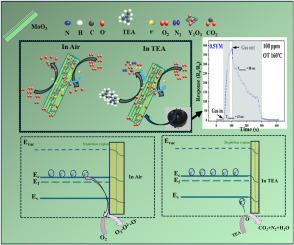MoO3/Y2O3 n-n heterojunction for enhanced triethylamine gas sensor
IF 4.6
3区 工程技术
Q2 ENGINEERING, ELECTRICAL & ELECTRONIC
引用次数: 0
Abstract
Effective detection of triethylamine (TEA) is critical for environmental and health monitoring. We synthesized MoO3/Y2O3 heterojunction sensors via facile hydrothermal method, varying Y2O3 loading (0.1, 0.3, 0.5, 2, and 4 wt %). The 0.5 YM sensor (0.5 wt % Y2O3) exhibited exceptional reproducibility and stability, achieving a response of 385.65 to 100 ppm TEA at 160 °C with a 50-ppb detection limit. This performance enhancement stems from Y2O3 induced oxygen vacancies (24.2 % valence oxygen), heterojunction driven charge transfer, and optimized pore structure (38 % larger pores). Characterization confirmed the heterostructure formation, crystallography, and surface properties, elucidating the sensing mechanism. The sensor demonstrated practical utility in real-time TEA monitoring, offering a viable strategy to enhance metal oxide gas sensors.

用于增强三乙胺气体传感器的MoO3/Y2O3 n-n异质结
三乙胺(TEA)的有效检测对环境和健康监测至关重要。我们通过简单的水热法合成了MoO3/Y2O3异质结传感器,不同的Y2O3负载(0.1,0.3,0.5,2和4 wt %)。0.5 YM传感器(0.5 wt % Y2O3)表现出优异的重复性和稳定性,在160°C下达到385.65至100 ppm TEA的响应,检测限为50 ppb。这种性能的增强源于Y2O3诱导的氧空位(24.2%的价氧)、异质结驱动的电荷转移和优化的孔隙结构(38%的孔隙增大)。表征证实了异质结构的形成、晶体学和表面性质,阐明了传感机制。该传感器在实时TEA监测中具有实用价值,为增强金属氧化物气体传感器提供了可行的策略。
本文章由计算机程序翻译,如有差异,请以英文原文为准。
求助全文
约1分钟内获得全文
求助全文
来源期刊

Materials Science in Semiconductor Processing
工程技术-材料科学:综合
CiteScore
8.00
自引率
4.90%
发文量
780
审稿时长
42 days
期刊介绍:
Materials Science in Semiconductor Processing provides a unique forum for the discussion of novel processing, applications and theoretical studies of functional materials and devices for (opto)electronics, sensors, detectors, biotechnology and green energy.
Each issue will aim to provide a snapshot of current insights, new achievements, breakthroughs and future trends in such diverse fields as microelectronics, energy conversion and storage, communications, biotechnology, (photo)catalysis, nano- and thin-film technology, hybrid and composite materials, chemical processing, vapor-phase deposition, device fabrication, and modelling, which are the backbone of advanced semiconductor processing and applications.
Coverage will include: advanced lithography for submicron devices; etching and related topics; ion implantation; damage evolution and related issues; plasma and thermal CVD; rapid thermal processing; advanced metallization and interconnect schemes; thin dielectric layers, oxidation; sol-gel processing; chemical bath and (electro)chemical deposition; compound semiconductor processing; new non-oxide materials and their applications; (macro)molecular and hybrid materials; molecular dynamics, ab-initio methods, Monte Carlo, etc.; new materials and processes for discrete and integrated circuits; magnetic materials and spintronics; heterostructures and quantum devices; engineering of the electrical and optical properties of semiconductors; crystal growth mechanisms; reliability, defect density, intrinsic impurities and defects.
 求助内容:
求助内容: 应助结果提醒方式:
应助结果提醒方式:


